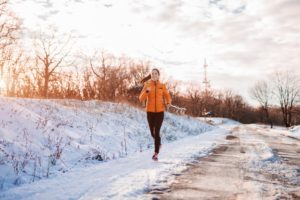
The temperature can influence the safety of your outdoor winter workout by putting a strain on your heart, muscles, skin, and more. It can also put you at risk for hypothermia, a sneaky condition that can creep up in a hurry.
Colder temperatures—specifically those 59 degrees F or lower (15 Celsius)—can cause blood vessels to narrow, so it’s’ harder for your heart to pump blood. If you’ve already got narrow blood vessels due to high blood pressure or atherosclerosis, these temperatures can be a critical factor. To reduce the risk of the cold on blood vessels, make sure you dress warmly from head to and bundle up with removable layers.
When the temperature trends downwards, your muscles are also at risk. When your blood vessels narrow, it’s harder to get oxygen-rich blood to the muscles. This lack of blood can limit elasticity and flexibility, creating an opportunity for strains or other injuries. To avoid this, make sure you dress warmly and warm up with some lighter-intensity exercise before hitting your stride. Your skin is also at risk of freezing when it is too cold outside, so be sure to cover your ears, lips, nose, and hands.
Ideally, getting out for your walk or jog in the middle of the day is best. It’s typically going to be warmer, and you’ll have better visibility, reducing the risk of slipping on some ice. Making sure you’re adequately hydrated before stepping out is also essential—the winter is quite dry, and you can become dehydrated rather quickly, especially if you’re sweating under all your layers.
And if it’s exceptionally cold, icy, windy, or there is blowing snow to eliminate visibility, it’s probably best to forego your outdoor workout and stick inside!